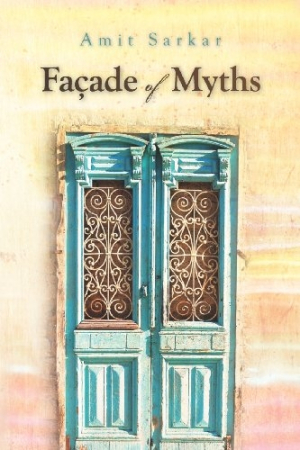Façade of Myths
“Myths are unreal renditions of social situations of the past,” writes Amit Sarkar in his memoir, Façade of Myths. “They are like potent fantasies that tend to lend credence to absurdity.”
Amit Sarkar grew up in a culture and family that were steeped in mythology. His grandmother was a fountain from which flowed so many tales of Krishna, Vishnu, Radha, and other “proliferating deities to crowd the Hindu pantheon” that she often joked of being “a story wizard.” His grandfather, a lawyer, philosopher, historian, and holy man all rolled into one, also filled Sarkar’s early life with tales of India and particularly of the Bengali region of Assam in which they lived. This mix of mythology and history helped make Amit Sarkar the man he later became: student, teacher, journalist, lawyer, and government secretary.
Façade of Myths is a single garment woven of three strands. The first is an episodic memoir that begins with the author growing up as a schoolboy in wartime British India. Snippets of family and student life offer a unique picture of a nation and a people in transition from colonial rule to independence.
The second strand is a history of India before, during, and after the British. Amit Sarkar focuses much of that story on the evils of partition—problems that continue to plague the subcontinent to this day. As a government secretary in the troubled Mizoram region, Sarkar deals with such issues daily and personally, witnessing riots and the assassination of three of his colleagues.
The book’s third strand is that of Hindu mythology, with which Sarkar’s grandmother imbued him in his childhood. Most of this is presented in the earliest chapters, yet it resurfaces throughout the memoir, as do the historical asides.
Sarkar’s volume is not seamless. At times it feels disjointed, especially when the author launches into discussions and observations of history and politics, going on for pages and pages before getting back to the episode in his life that served to spur that tangent. There are also several holes in the narrative—lengthy periods of his adult life that are ignored or dismissed with a line or two. In addition, readers will likely note the deep divide between the tales of Sarkar’s childhood and student days and the part of his story that focuses on his stint as a government official. This last third of the book is so different from the first two-thirds that it seems like an entirely different work.
That said, Sarkar’s writing is rich and personal, and the selected episodes of the author’s life are filled with humorous and touching anecdotes and personalities, the most memorable among them a businessman and a porter he meets on the train to university, as well as a shoeshine boy who befriends the young student. There is also a sweet story of a love that is never meant to be fulfilled, and which half a century later obviously still haunts the author in a gentle, warming wonder of what could have been.
Façade of Myths is well written in an English that is flavored with Indian melodies. Western readers will need a little time to tune their inner ear to the music, but once they do they will savor the language, as it is full of the flavor of an ancient culture that has survived imperial influences without succumbing to them.
Reviewed by
Mark McLaughlin
Disclosure: This article is not an endorsement, but a review. The publisher of this book provided free copies of the book and paid a small fee to have their book reviewed by a professional reviewer. Foreword Reviews and Clarion Reviews make no guarantee that the publisher will receive a positive review. Foreword Magazine, Inc. is disclosing this in accordance with the Federal Trade Commission’s 16 CFR, Part 255.

